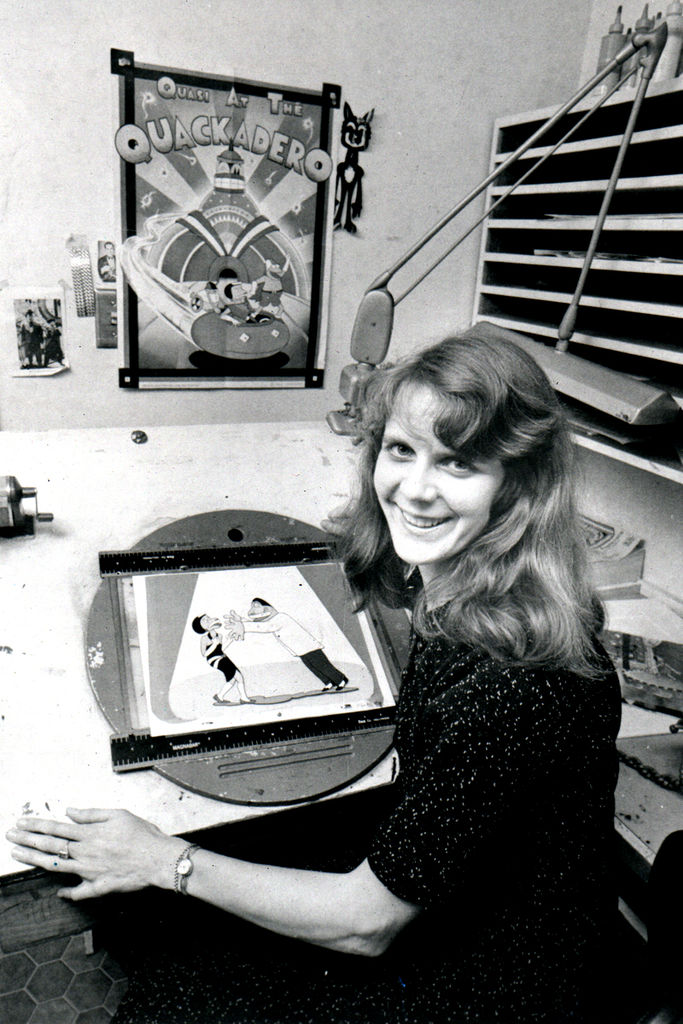Sally Cruikshank
Filed under: People, Animator, Artist, Cartoonist, Director, 1970s, 1980s, 1990s, 2000s, 2010s, Sally Cruikshank, Technicolor, U.S.A.,
 Full Name:
Full Name:Sally Cruikshank
Occupation / Title:Animator, Artist, Cartoonist, Director
Date of birth:?/?/1949
Date of death:present
Birthplace:Catham, New Jersey, USA
Associated studios:Snazelle Films
Biography
Sally Cruikshank is an American independent animator, cartoonist, and director. She is most known for her psychedelic and surrealist depictions of oftentimes anthropomorphic figures.
Cruikshank majored in art during undergraduate study at Smith College. During her fourth year of study, Cruikshank began self-taught animation and produced her first animated film, Ducky (1971) (“Gertie and Ducky: An Interview with Sally Cruikshank”). In the late 1960s, she graduated from Smith College and enrolled in the San Francisco Art Institute to pursue a career in animation, during which she created Fun on Mars (1971) and Chow Fun (1972) (Landekic “Sally Cruikshank: A Career Retrospective, Part 1”). Gregg Snazelle, director of Snazelle Films, took notice of Cruikshank, who was editing Chow Fun by that time. He hired Cruikshank to work at Snazelle Films on both commercials and experimental animations (Ibid.). In 1975, Cruikshank directed Quasi at the Quackadero, which found extreme popularity in the underground midnight movie circuit (Ibid.). She created another short, Make Me Psychic (1978) afterward, followed by a Quasi’s Cabaret trailer for a feature film that she envisioned but never completed (Ibid.).
From the late 70s to the end of the 80s, Cruikshank mostly worked on creating title sequences for films such as Ruthless People (David Zucker, 1986), Mannequin (Michael Gottlieb, 1987), Loverboy (Joan Micklin Silver, 1989), and Madhouse (Tom Ropelewski, 1990) (Ibid.). Other times she directed one animation sequence for Twilight Zone: The Movie (John Landis, 1983), a commercial for a candy called Candilicious in 1987, and an animated short Face Like a Frog (1987) (Landekic “Sally Cruikshank: A Career Retrospective, Part 2”).
In the early 90s, producer Arlene Sherman introduced Cruikshank to the animated television series Sesame Street (1969-present), which Cruikshank worked on for about fourteen years (Ibid.). The most famous animated sequence of all that Cruiskhank contributed to the series is From Your Head (1996) (Robinson).
From the 90s to the 2000s, Cruikshank experimented with digital technology, especially Flash, which she used to develop a chatbot called Whimsey and the main titles for Smiley Face (Gregg Araki, 2007) (Landekic “Part 2”). She ceased doing animation for a while, instead focusing on watercolour paintings until her involvement in the 2D hand-drawn animation for SpongeBob SquarePants stop-motion Halloween-themed special The Legend of Boo-Kini Bottom released in 2017 (“Gertie and Ducky”; “Screen Novelties Scares up Stop-Mo Magic for ‘SpongeBob’ Special”).
References:
Landekic, Lola. “Sally Cruikshank: A Career Retrospective, Part 1.” Art of the Title, 20 May 2015, www.artofthetitle.com/feature/sally-cruikshank-a-career-retrospective-part-one.
Landekic, Lola. “Sally Cruikshank: A Career Retrospective, Part 2.” Art of the Title, 27 May 2015, www.artofthetitle.com/feature/sally-cruikshank-a-career-retrospective-part-two.
“Screen Novelties Scares up Stop-Mo Magic for ‘SpongeBob’ Special.” Animation Magazine, 12 Oct. 2017, www.animationmagazine.net/2017/10/screen-novelties-scares-up-stop-mo-magic-for-spongebob-special.
“Gertie and Ducky: An Interview With Sally Cruikshank.” Pangolin Blues, 28 Oct. 2012, pangolinblues.wordpress.com/2012/10/28/gertie-and-ducky-an-interview-with-sally-cruikshank.
Robinson, Chris. “Know Your Indie Filmmaker: Sally Cruikshank.” Cartoon Brew, 17 July
